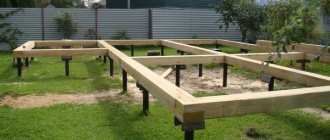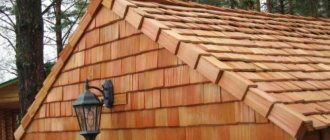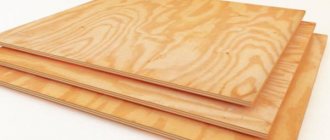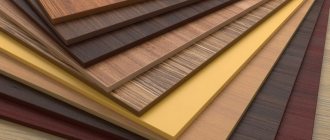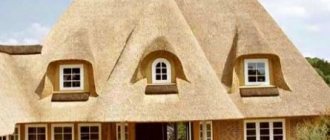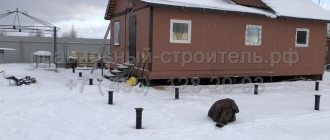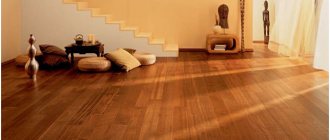- Posted by Anastasia Mikitalo
- Date: October 11, 2017
The developments of past centuries are taken as the basis for new building materials. Thus, shingles were used by our ancestors for many years as the main roofing covering that met the requirements of the standard of that time. Such a roof not only looked beautiful, but also provided reliable protection of residential premises from various kinds of negative factors. Modern developers classify shingles as refined, expensive materials that require special skills to perform flawless installation. Despite the lack of craftsmen who are well versed in the technology of work, as well as the high cost, you should pay attention to a shingle roof that will last for many decades.
- 2 Features of manufacturing roofing shingles
2.1 Instructions for preparing roofing shingles with your own hands2.1.1 Video: how to make shingles with your own hands
- 3.1 Video: laying shingles on the roof with your own hands
- 4.1 Service life of roofing shingles
Purpose and advantages of using shingles when installing a roof
Shingles are one of the impeccable natural and environmentally friendly materials, presented in the form of small wooden plates 3–8 mm thick, produced in widths of 8–16 cm and lengths of 35–45 cm. Common names for the material include wooden tiles, shingles, and shingles.
Shingles are a natural material
Depending on the manufacturing features, shingles can be of the following types:
- Split is the most practical due to such properties as preservation of shape and protection from rotting processes. When harvesting wood, the integrity of the tubular fibers is maintained, which prevents moisture from accumulating in the structure of the material.
- Sawn.
- Mosaic - widely used as a decorative covering.
A house with a shingle roof looks very colorful
The main positive properties of shingle roofing include:
- Tightness of the finishing coating.
- Long service life. Compliance with installation technology and proper care will allow the shingles to be used for at least 100 years.
- Reliability of the layer - the strength of the material is determined by natural conditions.
- Resistance to moisture in any conditions (rain, snow, ice).
- Good ventilation ability.
- High thermal insulation characteristics.
Regardless of the wishes of the owner of a private house and the design features of the roof, wooden tiles are available for any finishing option. The laying of shingles is carried out in the most severe climatic conditions when exposed to large snow covers, low temperatures, and gusty winds. This material can be used when constructing curved roofs, and the number of layers is determined based on the functions of the roof. To form a waterproof and dense coating, the shingles are installed in several layers.
Shingles have several names
When comparing shingles with other analogues, the difference in material properties and installation technology is noted. Elements of wooden tiles are attached according to the principle of scales in fir cones, as a result of which swelling and closing of the covering parts is achieved at high humidity, and when drying, the plates take on a dome-shaped shape, thereby releasing moisture out.
A house with a shingle roof will be comfortable even on hot summer days, since wood does not have the ability to transfer heat like metal or tiles.
The relief structure of the finishing layer serves as sound insulation for residential premises from the sound of rain and hail. Having a breathable natural base, shingles are naturally ventilated. To increase the service life of the load-bearing roof structure, it is recommended to install it using the “shingle-roof” principle. This will create an additional ventilated gap.
Features of manufacturing roofing shingles
The material is produced in two ways: manually and mechanically. For production, coniferous wood species (spruce, pine, larch) or aspen are selected. Thanks to the resin produced by trees, the material has natural antiseptic protection and is able to withstand temperature fluctuations. Summer, spring and autumn are the most suitable seasons for harvesting raw materials. The diameter of the trunk can be any, the main thing is that it is free from knots and defects, and its surface is as smooth as possible.
You can make shingles yourself
Sawn logs of the required size are manually processed by removing the core and bark. A distinctive feature of the industrial production of shingles is the cutting of logs into long logs and the subsequent production of timber, the width of which is equal to shingles. The wooden planks themselves are obtained by unraveling the timber.
The size of a hand-made chindel reaches 40–45 cm, parts that have undergone mechanical processing are 2 times longer, that is, 80–90 cm. The first option is used for standard roofing structures, the second is perfect for both roofs with long slopes and and for ordinary roofs, but it will be necessary to cut the shingles in half.
Instructions for preparing roofing shingles with your own hands
You can prepare the material for laying the roof yourself, following the sequence of work.
- Selecting a tree trunk that is smooth and free of cracks.
- Cutting logs 40–45 cm long.
- Preparation of thin log plates using the following technology:
- the log is cut in half or into four quarters,
- the bark is removed,
- the core is removed
- the remaining material is cut into thin plates - shingles 3-8 cm thick and the required width - from 8 to 18 cm.
For work you need to use only a sharp tool
The process can be simplified by using already machined wood and then sawing long planks into short elements. In this case, the material will last a shorter period, since the raw material was not split into fibers - it was simply cut. In a word, to preserve the quality of shingles, it is recommended to use the peeling method, which, although very time-consuming, is the most practical when harvesting the material manually.
Shingles can also be produced mechanically
Video: how to make shingles with your own hands
How to make shingles with your own hands
In the simplest case, for a small roof, you can cut the required amount of material manually. For example, use a carpenter's knife and a piece of a car spring with a welded handle.
The blanks of lumps or blocks are pre-cut with a chainsaw and carefully inspected for the presence of knots or wood defects. Logs with knots and uneven fiber structure are rejected; they are not suitable for roofing. Each block is divided into eight parts with an ax and a hammer, otherwise it will be difficult and physically difficult to chop off an even plank from the massif.
If the wood material is relatively smooth, for example, like aspen, then you can cut the log with a homemade device, as in the photo.
This method does not require special physical strength, and the quality of the shingles, and therefore the roof, will be much higher.
The chopped planks are stacked and subjected to manual trimming. In order for the roof to be dense, without holes and humps, it is necessary to calibrate and cut off excess wood from the workpiece. The last stage is drying; for laying on the roof it is best to use shingle boards with a humidity of 25%.
Laying shingles on a roof structure
When installing wooden tiles, it is enough to follow a number of rules, and then the coating will be durable and of high quality.
- The planks are attached overlapping onto the sheathing in 4 layers on the roofs of residential premises and in 2 layers on non-residential buildings. The sheathing can be made continuous or with slats placed at a distance of no more than 10 cm from each other. Laying shingles is allowed horizontally and vertically if the slope angle is more than 15 degrees.
The shingles must be laid with an overlap
- There is no need to do waterproofing on the roof, despite the advice of many developers that it is necessary to lay a layer of roofing material. Our ancestors did not resort to additional means of roof protection in the form of waterproofing or continuous sheathing, explaining this by the fact that wooden shingles needed to “breathe” freely. Roofing felt will not let air flow through, exposing the wood to rot. The shingles independently cope with the protective function: in wet weather it swells, closing the cracks in the roof, and in dry weather it shrinks, allowing air to freely penetrate into the under-roof space.
- The laying of the planks is carried out from the bottom up with the addition of a layer in the places where the slope descends and the installation of auxiliary boards 40 cm wide.
The shingles should be laid from bottom to top
- Self-tapping screws for working with shingles, pre-impregnated with drying oil, are used as fastening elements.
- In the process of splitting logs into planks, the wood fibers bend and rise, therefore, when creating the first row of plates, they should lie so that the pins point upward, and the subsequent ones are formed the other way around - with the pins facing down.
- Particular attention should be paid to the installation of shingles in the valley areas, where the sheathing is complemented by planks, and the shingles consist of more layers than the rest of the covering.
Do-it-yourself wooden shingles are highly resistant to bad weather, have impeccable sound insulation, and are not a source of static electricity accumulation.
Video: laying shingles on the roof with your own hands
Artificial shingles for roofing
In order to make a roof that matches the tone and color of a roofing covering made of natural shingles, it is not necessary to buy a machine or expensive material made of cedar or oak. Already today, signs and shingles pressed from a mixture of polyvinyl chloride, polypropylene and wood flour are increasingly used instead of natural wood.
Essentially, this is the same decking board, but designed in the form of a shingle board. The color and texture of the roofing material can be anything, from freshly cut cedar to old bog oak. The material does not require maintenance, is not afraid of sunlight, frost and does not absorb moisture at all, which means there are no problems with condensation and rainwater.
The only serious drawback of artificial shingles is its flammability. Despite the fact that American roofing manufacturers assure that the material is not afraid of heat and does not support combustion, in practice a slightly different picture emerges. When an attic or roof rafter catches fire in a fire, synthetic PVC wood releases huge amounts of chlorinated ethylene, an extremely dangerous and poisonous gas.
That is why polyvinyl chloride in its pure form is not used for roofing work; most often the polymer is used as protective coatings of small thickness.
Replacing old shingles
To remove a damaged roofing element, use a peg to lift the solid shingles located above the one being replaced. The defective part is split into pieces with a chisel and removed. The remaining screw heads are cut off.
If several rows are to be replaced, then work begins with the lowest elements. New tiles are cut according to the parameters of the resulting void so that there is a gap of at least 6 mm at each edge of the strip.
If the new element does not fit into the opening or enters at a different angle, it is enough to cut off part of its thin end. The shingles should be started by tapping on the block.
Roofing shingle service life
Among the factors that have a great influence on the lifespan of the roof are:
- selected wood,
- harvesting technologies used,
- features of raw material processing.
Subject to the rules of wood harvesting, when sawing of the material is completely eliminated, a shingle roof can last for many decades, up to 100 years. If the material was obtained by cutting immature wood, then you will have to think about replacing the roof in a few years. An important point is the maintenance of the finished product. Thus, with timely processing of wooden elements, a long service life can be achieved.
The service life of shingles is about 100 years
Wood roofing is at great risk from exposure to sunlight and wind. This leads to drying of its fibers. Loss of moisture is fraught not only with external changes in the coating, but also with the loss of its original properties. The tiles are gradually cracking, the tightness of the roofing layer is broken, and the roof needs repair.
No less dangerous for shingles is high humidity. If during installation some areas were laid in violation of the technology, then when the wood swells, proper ventilation will not be provided, which will lead to distortion of the entire canvas.
Ways to increase the service life of shingles
Wood is a raw material that reacts strongly to temperature fluctuations and changes in humidity levels. Therefore, the layer of varnish on it will quickly crack with constant expansion and contraction of the structure. Moisture will begin to penetrate through the resulting defects without the possibility of natural evaporation, which will lead to the proliferation of microorganisms and rotting. In order for wooden shingles to retain their pristine beauty and technical characteristics for a long time, it is enough to process it periodically. A large number of construction companies supply the market with special products for treating wooden structures to prevent rotting, drying and bacterial damage.
- Translucent penetrating oils occupy a leading position in the market. They impregnate the top layer of the coating. This treatment guarantees the preservation of the wood texture for many years.
- Water-repellent compounds - transparent impregnations on a wax or acrylic-resin basis help maintain the appearance of the roof, but due to their short protective effect they must be applied at regular intervals.
Wax-based compounds will help protect shingles from rotting.
- The use of varnish and paint is the most controversial way to treat a roof.
A flawless finish is achieved by completely immersing the wooden elements in a protective compound before they are secured to the roof. In the future, it will be enough to cover the surface with a protective agent using a brush or spray.
Types of wooden roofing coverings
To finish the bath roof, you can make the material yourself, or purchase a factory-made one. Factory options, of course, cannot be called cheap, but they are very impressive with their exquisite carvings and complete readiness for installation. The individual components of shingle coverings may differ in their configuration, manufacturing technology and installation method. Based on the listed characteristics, they can be divided into separate types.
Shingle
It was shingles that gave the name to all representatives of this category of materials.
What is it?
These are individual chipped or sawn plates that can have different longitudinal cuts: rectangular, dovetail or trapezoidal.
In the version with a tail, the tongue-and-groove planks are fixed to the sheathing and fastened to each other using the tongue-and-groove method.
If non-grooved material is used, that is, parts that are rectangular and trapezoidal in cut, they are connected to each other and fastened directly to the sheathing using nails or self-tapping screws. Such fasteners penetrate through a pair of plates (without a tongue), and enter the lath two centimeters.
Important note! Sawn material is very significantly inferior to chipped material in terms of technical and operational qualities. The fact is that when sawing, the natural structure of wood fiber is disrupted, and it no longer so valiantly resists various negative influences from the outside.
Chips and shingles
Chips and shingles are a simplified and lightweight version of shingles. They differ from each other in thickness and size. For roofing shingles the lengths range from 40 to 100 cm, for wood chips they are shorter. You can make both wood chips and shingles yourself: by chopping wood into separate planks of different formats. The log for such logs must be dried, and it must be of impressive size, otherwise you will end up with a lot of unusable planks.
If you make them from damp wood, then when drying, individual elements may crack. If the soft core of the log, called sapwood, is used, then planks made from it will not last for a long time. There should be no defects, knots or cracks on individual parts of the roofing shingles. Alder or aspen are best suited for this, but soft coniferous trees can be used.
The shingles are spread onto the roof surface in a checkerboard pattern, with overlaps vertically and horizontally, in two, four, three or five layers. To ensure that the boards fit correctly, their side cuts are chamfered. This is done at an angle of 45 degrees on both sides. Experienced craftsmen recommend chamfering from the transverse outer edge for beauty, and from the inner edge for a better fit.
Schindel
This is the name for tiles made of wood, which are not installed in a strict checkerboard pattern, but with some offset, but always overlapping. The result is a prototype of a flexible modern tile that cannot be rigidly attached to the sheathing - you must leave a small screw.
Individual tile elements are not mounted tightly, leaving free space to increase in size when wet, so that the planks abutting each other do not swell. When making a spindle, the carpenter takes into account the arrangement of the annual rings of the tree. Otherwise, when moistened and then dried, the tree will warp.
ploughshare
This is a special wooden roofing covering that has become truly legendary. Boyars' chambers and wooden churches have long been decorated with such carved splendor in Rus'. Each individual element of the plowshare covering is a real work of art. They are made by hand and always from aspen.
Moreover, wood should be harvested at a certain period - when the maximum amount of sap circulates through the fibers . This happens in the spring, at the very end. Each individual element looks like a neat spatula with edging, and the material for it must be selected especially carefully. This is an expensive roof covering, manufactured in specialized workshops for rare or valuable architectural forms.
Tes
The planks are simple coniferous boards that are laid on the roof along or across the eaves line. The latter option is more practical as it lasts longer. In the center of the boards installed across them, a special gutter is made for the outflow of water. The roofing is made of plank, in two layers, with or without a gap between them.
Fixed with one nail. The boards of the lower layer are placed with the core facing down, the boards of the top layer are first planed, then laid with the core facing out. If the laying direction goes along the eaves line, first fix the sheathing board, which will be needed as a stop for the very first row. Each subsequent row must overlap at least 5 cm with the previous one.
Making your own wood chips or shingles does not require any special experience or high qualifications. Even an inexperienced master can do such work. Although it is easier to process material that has natural moisture, it should not be done. It is necessary to put all the logs in a neat pile to dry.
A whole log takes about three years to mature . This period can be shortened if you cut it into 40-cm logs in advance. Then after 6-9 months you can start making shingles. Hard, well-dried wood is quite difficult to split. But for the sake of high-quality and wear-resistant roofing material, it is worth the effort.
Proper care of a wooden roof is the key to its long-term use
Like any structure, roofing shingles need proper maintenance, which even a novice master can handle:
- As the layer of snow accumulates, it is swept away with a broom, starting from the top - from the ridge element, ending with the edge of the slope.
- The lower rows of shingles are subject to displacement and require timely identification and repair.
- Fallen leaves in the fall are washed away by precipitation or fly off on their own, but you should not neglect cleaning the roof from branches and remaining leaves.
- Moss can grow on a wooden roof, so it is important to detect it in time and remove it by weeding or cutting it off with a spatula.
- Prolonged use of shingles can lead to clogging of drains with accumulated resin. The problem can be easily fixed by cleaning them inside.
